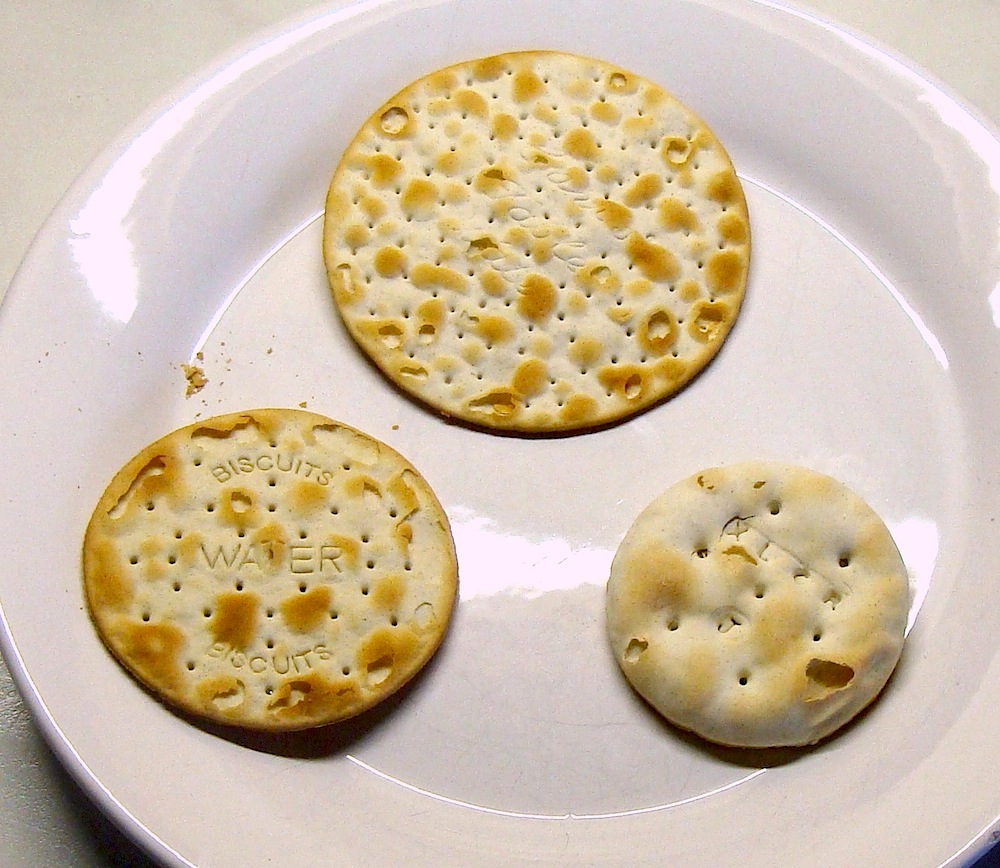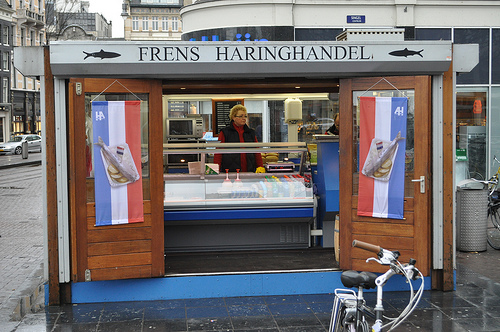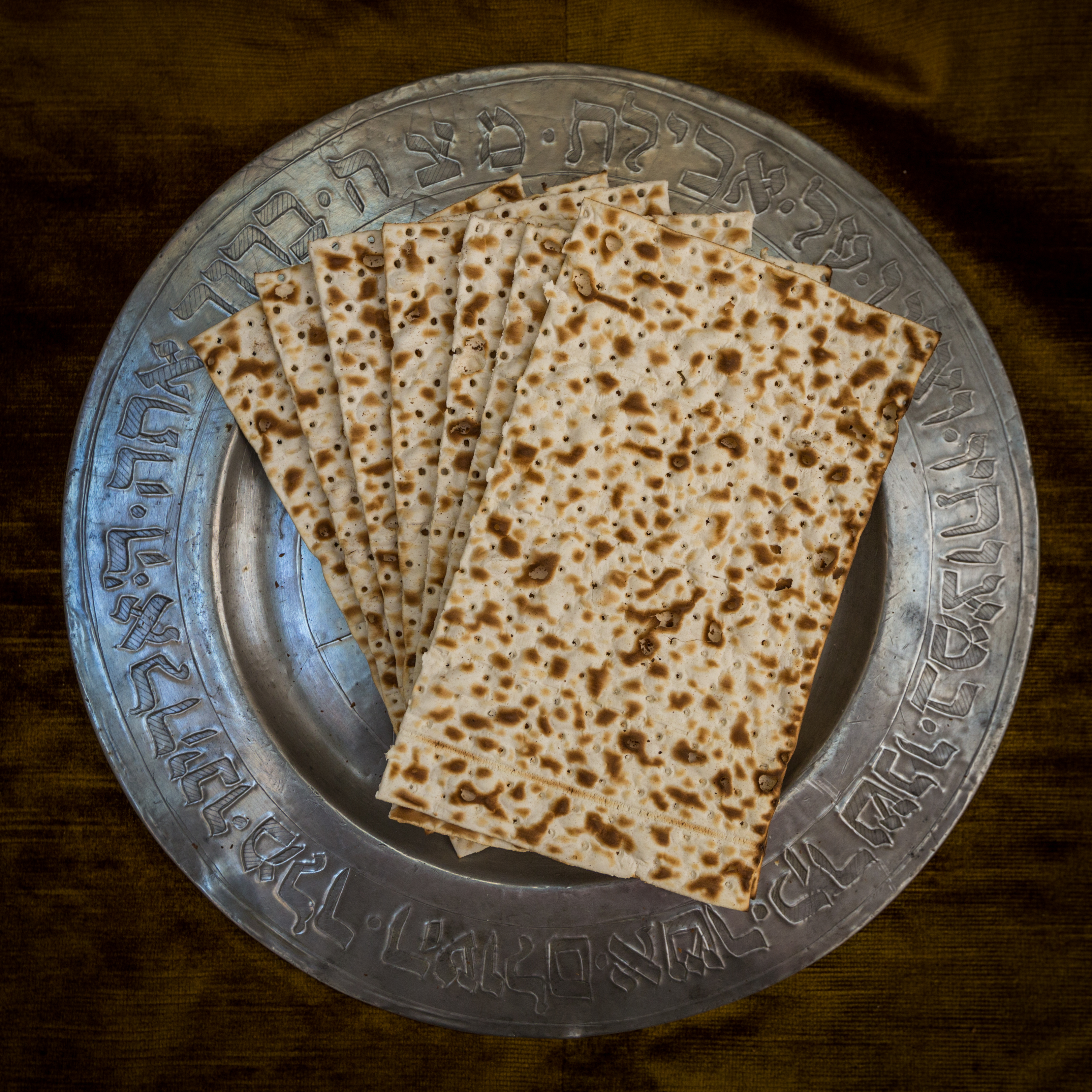|
Water Biscuit
A water biscuit or water cracker is a type of savoury cracker. They are thin, hard and brittle, and usually served with cheese or wine. Originally produced in the 19th century as a version of the ship's biscuit, water biscuits continue to be popular in Australia, New Zealand, South Africa, Ireland, and the United Kingdom, with the leading brands (Carr's and Jacob's) selling over seventy million packets a year. In 1801, Josiah Bent began a baking operation in Milton, Massachusetts, selling "water crackers" or biscuits made of flour and water that would not deteriorate during long sea voyages from the port of Boston. His company later sold the original hardtack crackers used by troops during the American Civil War. These were commercial versions/refinements of the hardtack biscuits which had long been used by the British Royal Navy and other European navies. Several versions of water crackers exist in ex- British colonies, such as Jamaica, where Excelsior brand water biscuits ... [...More Info...] [...Related Items...] OR: [Wikipedia] [Google] [Baidu] |
Herring (food)
Herring are forage fish in the wild, mostly belonging to the family Clupeidae, but they are also an important food for humans. Herring often move in large schools around fishing banks and near the coast. The most abundant and commercially important species belong to the genus ''Clupea'', found particularly in shallow, temperate waters of the North Pacific and North Atlantic Oceans, including the Baltic Sea, as well as off the west coast of South America. Three species of ''Clupea'' are recognized; the main taxon, the Atlantic herring, accounts for over half the world's commercial capture of herrings. Herrings played a pivotal role in the history of marine fisheries in Europe, and early in the twentieth century, their study was fundamental to the evolution of fisheries science.Pauly, Daniel (2004''Darwin's Fishes: An Encyclopedia of Ichthyology, Ecology, and Evolution''Page 109, Cambridge University Press. . These oily fish also have a long history as an important food fish, an ... [...More Info...] [...Related Items...] OR: [Wikipedia] [Google] [Baidu] |
Hardtack
Hardtack (or hard tack) is a simple type of dense biscuit or cracker made from flour, water, and sometimes salt. Hardtack is inexpensive and long-lasting. It is used for sustenance in the absence of perishable foods, commonly during long sea voyages, land migrations, and military campaigns. Along with salt pork, hardtack was a standard ration for many militaries and navies from the 17th through the early 20th centuries. Etymology The name is derived from "tack", the British sailor slang for food. It is known by other names including ''brewis'' (possibly a cognate with "brose"), ''cabin bread'', ''pilot bread'', ''sea biscuit'', ''soda crackers'', ''sea bread'' (as rations for sailors), ''ship's biscuit'', or pejoratively as ''dog biscuits'', ''molar breakers'', ''sheet iron'', ''tooth dullers'', ''armor plates'' (Germany) and ''worm castles''. Australian and New Zealand military personnel knew them with some sarcasm as ''ANZAC wafers'' (not to be confused with Anzac biscuit). ... [...More Info...] [...Related Items...] OR: [Wikipedia] [Google] [Baidu] |
Matzo
Matzah or matzo ( he, מַצָּה, translit=maṣṣā'','' pl. matzot or Ashk. matzos) is an unleavened flatbread that is part of Jewish cuisine and forms an integral element of the Passover festival, during which '' chametz'' ( leaven and five grains that, per Jewish Law, are self-leavening) is forbidden. As the Torah recounts, God commanded the Israelites (modernly, Jews and Samaritans) to eat only unleavened bread during the seven day Passover festival. Matzah can be either soft like a pita loaf or crispy. Only the crispy variety is produced commercially because soft matzah has a very short shelf life. Matzah meal is crispy matzah that has been ground to a flour-like consistency. Matzah meal is used to make matzah balls, the principal ingredient of matzah ball soup. Sephardic Jews typically cook with matzah itself rather than matzah meal. Matzah that is kosher for Passover is limited in Ashkenazi tradition to plain matzah made from flour and water. The flour ... [...More Info...] [...Related Items...] OR: [Wikipedia] [Google] [Baidu] |
Saltine Cracker
A saltine or soda cracker is a thin, usually square cracker usually made from white flour, sometimes yeast (although many are yeast free), and baking soda, with most varieties lightly sprinkled with coarse salt. It has perforations over its surface, as well as a distinctively dry and crisp texture. Some familiar brand names of saltine crackers in the Americas are Christie's '' Premium Plus'' (Canada), Nabisco's ''Premium'' (U.S.), Sunshine Biscuits' ''Krispy'' (U.S.), Keebler's ''Zesta'' (U.S.) (both owned by Kellogg's), Molinos Modernos' ''Hatuey'' (Dominican Republic) and Noel's Saltín (Colombia). Unsalted tops as well as whole grain saltines can also be found. History Soda crackers were described in ''The Young House-keeper'' by William Alcott in 1838. In 1876, F. L. Sommer & Company of St. Joseph, Missouri started using baking soda to leaven its wafer thin cracker. Initially called the Premium Soda Cracker and later "Saltines" because of the baking salt component, t ... [...More Info...] [...Related Items...] OR: [Wikipedia] [Google] [Baidu] |
Cream Cracker
Cream cracker is a flat, usually square, savoury biscuit. The name "cream crackers" refers to the method in which the mixture is creamed during manufacture. The cream cracker is traditionally prepared using fermented dough. They are made from wheat flour, vegetable oil and yeast, and are commonly served with cheese, corned beef or other savoury topping such as Marmite or Vegemite. They are also eaten with butter or margarine or without accompaniment. An average cream cracker contains about 35 kcal. History The cream cracker was invented by Joseph Haughton at his home in Dublin, Ireland, and then manufactured by William Jacob in a small bakery around 1885. Distribution Cream crackers are popular in the United Kingdom, Ireland, Argentina (brands include Traviata, manufactured by Grupo Arcor, and Express, manufactured by Mondelez), Taiwan, Peru, Chile, Brazil, Southeast Asia, South Asia and South Africa. The most widely known cream cracker brand is Jacob's. The Jacob' ... [...More Info...] [...Related Items...] OR: [Wikipedia] [Google] [Baidu] |
Solomon Gundy
Solomon Gundy is a Jamaican pickled (with salt) fish pâté usually served with crackers as an appetizer. The pâté is made with smoked red herring (although other fish such as mackerel and shad are also sometimes usedSolomon-a-Gundy Jamaican recipes) and is minced and spiced with s and seasonings. The dish appears on the menus of Jamaican restaurants and resorts. It is also sold as a packaged food for export. The term may come from the British word '''', used to refer to a |
Jamaica
Jamaica (; ) is an island country situated in the Caribbean Sea. Spanning in area, it is the third-largest island of the Greater Antilles and the Caribbean (after Cuba and Hispaniola). Jamaica lies about south of Cuba, and west of Hispaniola (the island containing the countries of Haiti and the Dominican Republic); the British Overseas Territory of the Cayman Islands lies some to the north-west. Originally inhabited by the indigenous Taíno peoples, the island came under Spanish rule following the arrival of Christopher Columbus in 1494. Many of the indigenous people either were killed or died of diseases, after which the Spanish brought large numbers of African slaves to Jamaica as labourers. The island remained a possession of Spain until 1655, when England (later Great Britain) conquered it, renaming it ''Jamaica''. Under British colonial rule Jamaica became a leading sugar exporter, with a plantation economy dependent on the African slaves and later their des ... [...More Info...] [...Related Items...] OR: [Wikipedia] [Google] [Baidu] |
British Empire
The British Empire was composed of the dominions, colonies, protectorates, mandates, and other territories ruled or administered by the United Kingdom and its predecessor states. It began with the overseas possessions and trading posts established by England between the late 16th and early 18th centuries. At its height it was the largest empire in history and, for over a century, was the foremost global power. By 1913, the British Empire held sway over 412 million people, of the world population at the time, and by 1920, it covered , of the Earth's total land area. As a result, its constitutional, legal, linguistic, and cultural legacy is widespread. At the peak of its power, it was described as " the empire on which the sun never sets", as the Sun was always shining on at least one of its territories. During the Age of Discovery in the 15th and 16th centuries, Portugal and Spain pioneered European exploration of the globe, and in the process established larg ... [...More Info...] [...Related Items...] OR: [Wikipedia] [Google] [Baidu] |
Royal Navy
The Royal Navy (RN) is the United Kingdom's naval warfare force. Although warships were used by English and Scottish kings from the early medieval period, the first major maritime engagements were fought in the Hundred Years' War against France. The modern Royal Navy traces its origins to the early 16th century; the oldest of the UK's armed services, it is consequently known as the Senior Service. From the middle decades of the 17th century, and through the 18th century, the Royal Navy vied with the Dutch Navy and later with the French Navy for maritime supremacy. From the mid 18th century, it was the world's most powerful navy until the Second World War. The Royal Navy played a key part in establishing and defending the British Empire, and four Imperial fortress colonies and a string of imperial bases and coaling stations secured the Royal Navy's ability to assert naval superiority globally. Owing to this historical prominence, it is common, even among non-Britons, ... [...More Info...] [...Related Items...] OR: [Wikipedia] [Google] [Baidu] |
American Civil War
The American Civil War (April 12, 1861 – May 26, 1865; also known by other names) was a civil war in the United States. It was fought between the Union ("the North") and the Confederacy ("the South"), the latter formed by states that had seceded. The central cause of the war was the dispute over whether slavery would be permitted to expand into the western territories, leading to more slave states, or be prevented from doing so, which was widely believed would place slavery on a course of ultimate extinction. Decades of political controversy over slavery were brought to a head by the victory in the 1860 U.S. presidential election of Abraham Lincoln, who opposed slavery's expansion into the west. An initial seven southern slave states responded to Lincoln's victory by seceding from the United States and, in 1861, forming the Confederacy. The Confederacy seized U.S. forts and other federal assets within their borders. Led by Confederate President Jefferson Da ... [...More Info...] [...Related Items...] OR: [Wikipedia] [Google] [Baidu] |
Milton, Massachusetts
Milton is a town in Norfolk County, Massachusetts, United States and an affluent suburb of Boston. The population was 28,630 at the 2020 census. Milton is the birthplace of former U.S. President George H. W. Bush, and architect Buckminster Fuller. Milton was ranked by Money as the 2nd, 7th, 8th, and 17th best place to live in the United States in 2011, 2009, 2019, 2021, and 2022 respectively. Milton is located in the relatively hilly area between the Neponset River and Blue Hills, bounded by Brush Hill to the west, Milton Hill to the east, Blue Hills to the south and the Neponset River to the north. It is also bordered by Boston's Dorchester and Mattapan neighborhoods to the north and its Hyde Park neighborhood to the west; Quincy to the southeast; Randolph to the south, and Canton to the west. History Indigenous peoples The area now known as Milton was inhabited for tens of thousands of years prior to European colonization. The Paleoamerican archaeological site Fowl Meado ... [...More Info...] [...Related Items...] OR: [Wikipedia] [Google] [Baidu] |





